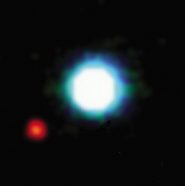A very distant planet says “cheese”
A small red spot may be the first picture ever taken of a planet outside the solar system.
Share this:
- Share via email (Opens in new window) Email
- Click to share on Facebook (Opens in new window) Facebook
- Click to share on X (Opens in new window) X
- Click to share on Pinterest (Opens in new window) Pinterest
- Click to share on Reddit (Opens in new window) Reddit
- Share to Google Classroom (Opens in new window) Google Classroom
- Click to print (Opens in new window) Print
By Emily Sohn
Distant planets tend to be pretty camera-shy.
Astronomers have found evidence of more than 125 planets around other stars in the universe, but no one has ever seen one directly. These planets are so faint they get lost in the glare of their parent star. Instead, astronomers have relied on indirect clues about how the planets affect nearby objects to pinpoint them.
 |
|
This photo, taken in near-infrared light, shows a red spot that may be a planet orbiting a type of star called a brown dwarf. The star is 230 light-years from Earth.
|
| European Southern Observatory |
Now, scientists may have finally snapped a photo of an extrasolar planet. It orbits a star 230 light-years from Earth. The star is a brown dwarf, a collapsed ball of gas that doesn’t give off light the way most stars do.
The planet is about 55 times as far from the star as Earth is from the sun. It also appears to be huge—about five times as massive as Jupiter.
To get the picture, astronomers from the European Southern Observatory used something called an adaptive-optics system on the Observatory’s Very Large Telescope in Paranal, Chile. The system has a special mirror that keeps changing shape. The technology removes blurring caused by turbulence in our planet’s atmosphere.
Besides getting the planet’s image, the researchers were also able to determine that the object contains water vapor. That would make it too cool to be another star.
Next, the researchers plan to follow the movement of the object, to make sure it behaves like a true planet and orbits the star.







